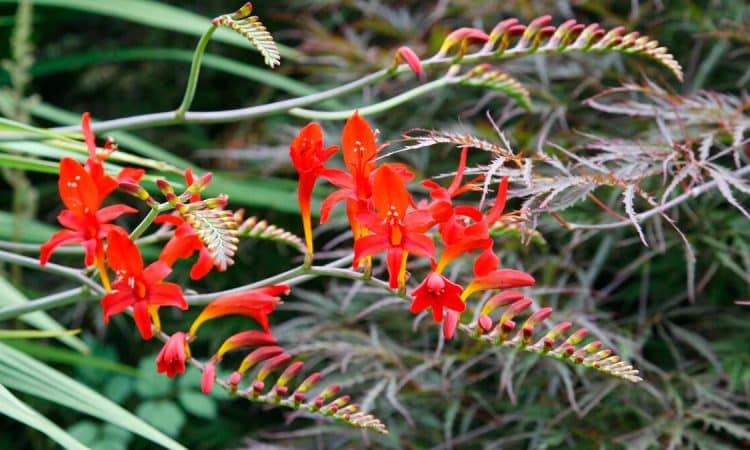
Montbretias occasionally miss their flowers. With just a few measures, you can ensure that these enchanting bulbous plants flower well every year.
Montbretias are among the most beautiful flowering plants in the summer garden. But what can you do if you don’t get the blooms you hoped for? The most important magic words here are: a sunny location, the right fertilization and suitable protection in winter.
The montbretias in our gardens, which bloom red, orange and yellow from July, are mostly hybrids of various species of the genus Crocosmia, which grow wild south of the Sahara. As Montbretias alternate between rainy and dry seasons in their native habitat, they have developed tubers that enable them to survive periods of water shortage. This is why they are traded both as a flowering plant in summer and as dry tubers that are planted at the end of spring.
If you want to gain your first experience with montbretias, it is best to try out flowering plants in summer. The problem with Montbretia tubers is that they can dry out and pupate if they are not stored properly. If this happens, budding will be slow and even flowering montbretias will not form buds in the first year. In any case, Montbretia tubers must be watered for three or four hours before planting. It is also advisable to choose tubers with the names of proven varieties, for example Crocosmia x crocosmiiflora ‘Lucifer’ or ‘Emily McKenzie’.
To bloom profusely, montbretia needs sun and a sheltered spot
Whether a tuber in spring or a finished plant in summer – a montbretia needs a warm and sunny spot to flower. The plant should be in full sun for at least half a day in summer – every additional hour of sunshine per day increases the flowering pleasure. If the montbretia is to remain in the ground permanently, choose a sheltered spot near a hedge or heat-retaining wall, for example, so that cold winds do not freeze the soil through so quickly in winter. For montbretias to grow optimally and produce flowers, the soil must be nutrient-rich and well-drained and must not dry out completely. On the other hand,waterlogging and cold, damp soil will lead to stunted growth and death of the tubers. Good fertilization – not too rich in nitrogen – goes without saying, as montbretias are heavy feeders.
Lack of flowering due to incorrect overwintering
In areas with mild winters, almost all varieties in this country are sufficiently hardy. In harsh regions, it is better to always remove the tubers from the soil in the fall. The easiest and most gentle way to do this is to place the plants in spacious pots sunk into the beds. Montbretias in containers should also be kept cool but frost-free and dark over winter as a precaution.
If montbretias are planted in beds in regions with a wine-growing climate, for example, they can also overwinter outside. Place tubers about 20 centimetres deep, root balls as deep as they are in the pot. If the soil is as loose as it should be, experience has shown that the tubers will pull themselves down to their preferred soil depth over time. However, heavy frosts would severely damage them. A generous covering of foliage is therefore important, as it buffers temperature fluctuations and mitigates ground frost.
Tip: Thin out overly dense stands
Established stands of montbretia are among the most beautiful things that summer beds have to offer. But even here, the abundance of flowers can diminish for a simple reason: The good reproduction of the tubers leads to more and more plants competing for space and food. If you notice that your Montbretia pulks are becoming lazy to flower, pick up the tubers in the fall, overwinter them frost-free and plant them in fresh ground at greater intervals next spring. It is important that no montbretias have previously grown in the new location or that the soil has been replaced. Don’t forget to fertilize well, then you will soon have your Montbretia splendour again.
Summer-flowering bulb flowers in the podcast
Montbretias are among the most beautiful summer-flowering bulbs for perennial beds. But there are many more to discover. In “Grünstadtmenschen – der Gartenpodcast”, Karina Dinser-Nennstiel and Sabrina Halbritter present summer-flowering bulbs that are planted in spring and bring color and exclusive flower shapes to the flower bed. Listen now!

